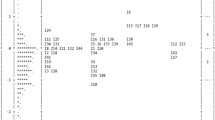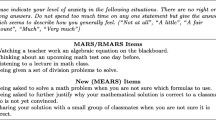Abstract
An exploratory factor analysis and several confirmatory analyses were performed to evaluate the factorial structure of the Revised Mathematics Anxiety Rating Scale (RMARS) through the responses of 805 college students. On 559 students’ scores, the instrument’s construct validity was tested through a confirmatory factor analysis (CFA) and was found to be inadequate. An exploratory factor analysis suggested a modification by dropping five items. After the modification, a second CFA showed that the modified model fit the theoretical model well. Cross-validation of the modified model was tested on a different sample of 246 students and was found to be satisfactory. In addition, concurrent validity of the instrument was found from significant relationships between the modified RMARS scores and students’ self-perceptions of their general and current mathematics anxiety levels. The modified RMARS is valid and reliable and could be used as a screening tool, a placement tool, or a research tool.
Similar content being viewed by others
References
ALEXANDER, L., & COBB, R. (1984). Identification of the dimensions and predictions of mathematics anxiety among college students. Paper presented at the meeting of the Mid-South Educational Research Association, New Orleans, LA.
ALEXANDER, L., & MARTRAY, C. (1989). The development of an abbreviated version of the Mathematics Anxiety Rating Scale. Measurement and Evaluation in Counseling and Development, 22, 143–150.
ATKINSON, R. T. (1988). An exploration of the factors relating to the system of mathematics anxiety. Unpublished doctoral dissertation, Oklahoma State University.
BALOĞLU, M. (2001). An application of structural equation modeling techniques in the prediction of statistics anxiety among college students. Unpublished doctoral dissertation, Texas A&M University.
BALOĞLU, M. (2004a). Statistics anxiety and mathematics anxiety: Some interesting differences I. Educational Research Quarterly, 27, 38–48.
BALOĞLU, M. (2004b). The relationship between subjective and objective assessment of college students’ mathematics anxiety levels. Proceedings of the Second International Balkan Educational Sciences Conference, September 8–10, Edirne, Turkey, 231–234.
BARTLETT, M. S. (1954). A note on the multiplying factors for various chi square approximations. Journal of the Royal Statistical Society, 16, 296–298.
BENTLER, P. M. (1990). Comparative fit indexes in structural models. Psychological Bulletin, 107, 238–246.
BENTLER, P. M. (1992). Eqs structural equations program manual. Los Angeles: BMDP Statistical Software, Inc.
BENTLER, P. M. (1995). Eqs structural equations program manual. Encino, CA: Multivariate Software, Inc.
BENTLER, P. M., & BONETT, D. G. (1980). Significance tests and goodnessof-fit in the analysis of covariance structures. Psychological Bulletin, 88, 588–606.
BENTLER, P. M., & WU, J. C. E. (1993). Eqs/Windows user’s guide. Los Angeles: BMDP Statistical Software, Inc.
BESSANT, K. C. (1995). Factors associated with types of mathematics anxiety in college students. Journal for Research in Mathematics Education, 26, 327–345.
BOLLEN, K. A. (1989). Structural equations with latent variables. New York: Wiley.
BOWD, A, D., & BRADY, P. H. (2002). Factorial structure of the Revised Mathematics Anxiety Rating Scale for undergraduate education majors. Psychological Reports, 91, 199–200.
BRUSH, L. R. (1981). Some thoughts for teachers on mathematics anxiety. Arithmetic Teacher, 29, 37–39.
CAMP, C. C. (1992). A comparison of the math anxiety and math self-efficacy constructs. Unpublished doctoral dissertation, Virginia Commonwealth University.
CAPRARO, M. M., CAPRARO, R. M., & HENSON, R. K. (2001). Measurement error of scores on the Mathematics Anxiety Rating Scale across studies. Educational and Psychological Measurement, 61, 373–386.
CATTELL, R. B. (1966). The scree test for the number of factors. Multivariate Behavioral Research, 1, 245–276.
DEW, K. M. H., GALASSI, J. P., & GALASSI, M. D. (1984). Math anxiety: Relation with situational test anxiety, performance, physiological arousal, and math avoidance behavior. Journal of Counseling Psychology, 31, 580–583.
DREGER, R. M., & AIKEN, L. R. (1957). The identification of number anxiety in a college population. Journal of Educational Psychology, 48, 344–351.
DUTTON, W. H., & BLUM, M. P. (1968). The measurement of attitudes towards arithmetic with a Likert-type test. Elementary School Journal, 2, 259–263.
FENNEMA, E., & SHERMAN, J. A. (1976). Fennema-Sherman Mathematics Attitude Scale: Instruments designed to measure attitudes toward the learning of mathematics by females and males. Jas Catalog of Selected Documents in Psychology, 6, 31.
FERGUSON, R. D. (1986). Abstraction anxiety: A factor of mathematics anxiety. Journal of Research in Mathematics Education, 17, 145–150.
GOUGH, M. F. (1954). Mathemaphobia: causes and treatments. Clearing House, 28, 290–294.
JÖRESKOG, K. G., & SÖRBOM, D. (1988). Lisrel 7: A guide to the program and applications. Chicago: Spss, Inc.
KAISER, H. F. (1974). An index of factorial simplicity. Psychometrica, 39, 401–415.
KAZELSKIS, R. (1998). Some dimensions of mathematics anxiety: A factor analysis across instruments. Educational and Psychological Measurement, 58, 623–633.
LEVITT, E., & HUTTON, L. (1984). A psychometric assessment of the Mathematics Anxiety Rating Scale. International Review of Applied Psychology, 33, 233–242.
LING, J. L. (1982). A factor analytic study of mathematics anxiety. Unpublished doctoral dissertation, Virginia Polytechnic Institute and State University.
MARDIA, K. V. (1970). Measures of multivariate skewness and kurtosis with applications. Biometrika, 57, 519–530.
MARDIA, K. V. (1974). Applications of some measures of multivariate skewness and kurtosis in testing normality and robustness studies. Sankhya, Series B, 36, 115–128.
MOORE, B., ALEXANDER, L., REDFIELD, D., & MARTRAY, C. (1988). The Mathematics Anxiety Rating Scale Abbreviated: A validity study. Paper presented at the meeting of the American Educational Research Association, New Orleans.
PLAKE, B. S, & PARKER, C. S. (1982). The development and validation of a revised version of the Mathematics Anxiety Rating Scale. Educational and Psychological Measurement, 42, 551–557.
RESNICK, J. H., VIEHE, J., & SEGAL, S. (1982). Is math anxiety a local phenomenon? A study of prevalence and dimensionality. Journal of Counseling Psychology, 29, 39–47.
RICHARDSON, F. C., & SUINN, R. M. (1972). The Mathematics Anxiety Rating Scale: Psychometric data. Journal of Counseling Psychology, 19, 551–554.
ROUNDS, J. B., & HENDEL, D. D. (1980). Measurement and dimensionality of mathematics anxiety. Journal of Counseling Psychology, 27, 138–149.
SANDMAN, R. S. (1980). The mathematics attitude inventory: Instrument and user’s manual. Journal for Research in Mathematics Education, 11, 148–149.
SATAKE, E., & AMATO, P. P. (1995). Mathematics anxiety and achievement among Japanese elementary school students. Educational and Psychological Measurement, 55, 1000–1007.
SATORRA, A., & BENTLER, P. M. (1988a). Scaling corrections for chi square statistics in covariance structure analysis. American Statistical Association 1988 Proceedings of the Business and Economics Sections (pp. 308–313). Alexandria, VA: American Statistical Association.
SATORRA, A., & BENTLER, P. M. (1988b). Scaling corrections for statistics in covariance structure analysis. (Ucla Statistics Series 2). Los Angeles: University of California at Los Angeles.
SPIELBERGER, C. D. (1980). Preliminary professional manual for the Test Anxiety Inventory. Palo Alto, CA: Consulting Psychologists Press.
SPIELBERGER, C. D., GORSUCH, R. L., LUSHENE, R. E., VAGG, P. R., & JACOBS, G. A. (1983). State-Trait Anxiety Inventory for adults sampler set: Manual, test, scoring key. California: Mind Garden.
Spss, Inc. (1998). SPSS Base 10.0 Applications Guide. Chicago: SPSS Inc.
STEIGER, J. H. (1990). Structural model evaluation and modification: An interval estimation approach. Multivariate Behavioral Research, 25, 173–180.
STRAWDERMAN, V. W. (1985). A description of mathematics anxiety using an integrative model. Unpublished doctoral dissertation, Georgia State University.
SUINN, R. M., EDIE, C. A., NICOLETTI, E., & SPINELLI, P. R. (1972). The Mars, a measure of mathematics anxiety: Psychometric data. Journal of Clinical Psychology, 28, 373–375.
SUINN, R. M., & EDWARDS, R. (1982). The measurement of mathematics anxiety. The Mathematics Anxiety Rating Scale for Adolescents—Mars-A. Journal of Clinical Psychology, 38, 576–577.
SUINN, R. M., & WINSTON, E. H. (2003). The Mathematics Anxiety Rating Scale, a brief version: Psychometric data. Psychological Reports, 92, 167–173.
TABACHNICK, B. C., & FIDELL, L. S. (2001). Using multivariate statistics (4th ed.). Needham Heights, MA: Allyn & Bacon.
WIGFIELD, A., & MEECE, J. L. (1988). Math anxiety in elementary and secondary school students. Journal of Educational Psychology, 80, 210–216.
WOOD, E. F. (1988). Math anxiety and elementary teachers: What does research tell us? For the Learning of Mathematics, 8, 8–13.
YAMADA, G., & PANDEY, S. (1995). Effect of sample size on goodness-of-fit indices in structural equation models. Journal of Social Service Research, 20, 49–70.
Author information
Authors and Affiliations
Corresponding author
Additional information
The authors express their gratitude to two anonymous reviewers, whose comments and suggestions led to a more comprehensive paper. Special thanks to Philip Brady, Ph.D., for allowing us to use a data set (Bowd & Brady, 2002).
Rights and permissions
About this article
Cite this article
Baloğlu, M., Zelhart, P.F. Psychometric Properties of the Revised Mathematics Anxiety Rating Scale. Psychol Rec 57, 593–611 (2007). https://doi.org/10.1007/BF03395597
Published:
Issue Date:
DOI: https://doi.org/10.1007/BF03395597




